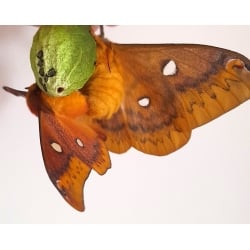- Current EGGS and LARVAE (54)
- EXOTIC BUTTERFLY PUPAE (11)
- MARKET STALL Everything a BARGAIN! (22)
- XXP super fast EXPRESS COURIER DELIVERY (2)
- CURRENT PUPAE - Chrysalides and cocoons (45)
- SILKWORM EGGS and Silkworms (6)
- SPRING and SUMMER EGGS and LARVAE Order now for supply in season (73)
- SPRING and SUMMER PUPAE You can order these NOW in advance (25)
- GIFT SUGGESTIONS (29)
- WINTER PUPAE for breeding in the following season (30)
- CAGES (10)
- PHASMIDS Leaf & Stick Insects, Mantids and more (2)
- SCHOOLS Recommended Livestock (14)
- SLEEVES for REARING LARVAE (7)
- PLASTIC REARING CONTAINERS (2)
- EQUIPMENT (29)
- MOTH TRAPS (7)
- NETTING (3)
- BOOKS (39)
- CHARTS (21)
- SPECIMENS for collectors (151)
- SILK Yarn, Fibres, Silkworm eggs (7)
Squeaking Silkmoth Rhodinia fugax Far East 15 eggs
We are sure that Rhodinia fugax will bring a lot of pleasure to breeders, and happy memories to those who have reared the Squeaking Silkmoth before.
Large larvae squeak when touched or disturbed by noise. Even the pupa squeaks within the extraordinary cocoon, which is green and shaped like a pitcher plant, with an open top. The vessel would fill with water when it rains, but the caterpillar spins a drainage hole in the bottom!
Foodplants include Oak, Sycamore, Maples, Willows and Sallows, Osier, Beech, Hawthorn, and doubtless many other trees and shrubs. Younger larvae change colour at each skin change. Final instar larvae have a clearly defined lateral demarkation between a dark green underside and bright lime green topside, which breaks the recogniseable shape of the caterpillar and helps it to avoid detection by predators.
Moths emerge in autumn. Males are beautifully patterned in chestnut brown. Females are much larger, and patterned in yellow. Eggs laid in autumn remain unhatched until buds open in the spring. Store in a fridge or very cold place, slightly humid, but beware of mould. Don't keep them chilled longer than necessary. You should incubate the eggs as early as food is available in spring. March and April are the best months to incubate.













